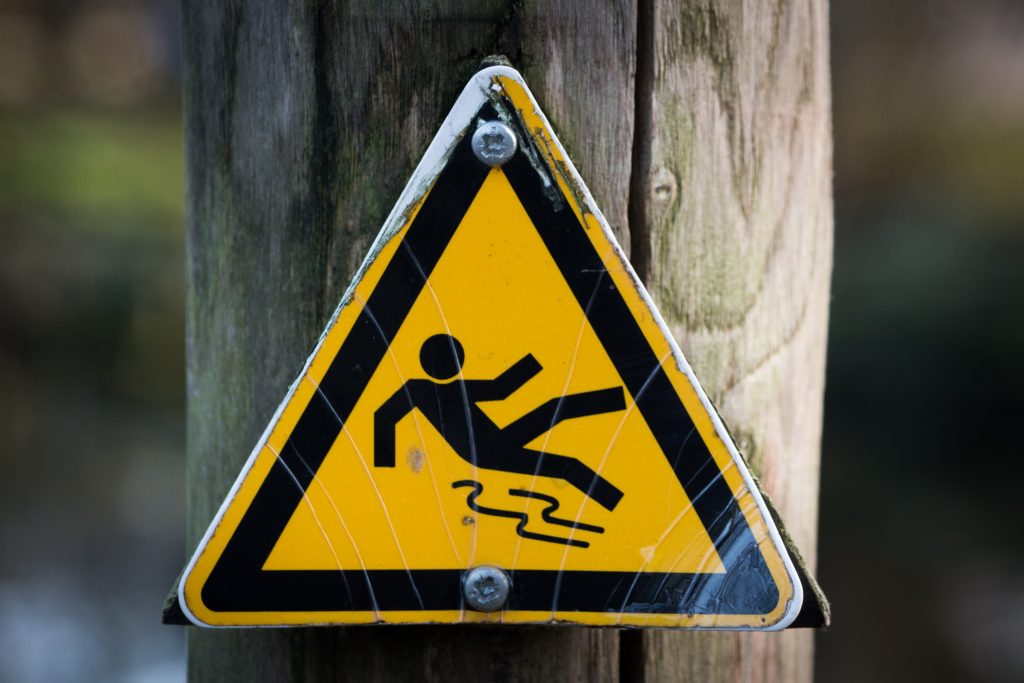 There’s a general understanding between a buyer and a seller that the seller will provide the good in an acceptable condition for a buyer. If the product is faulty, then the general understanding is that the seller will take responsibility for making things right as soon as they can. This is even solidified by warranties. What happens, then, when a construction company sells a New Orleans resident a roof that leaks so much it leads to a man slipping and falling? Is the danger created by the leak so obvious that the construction company shouldn’t be held liable for the injury?
There’s a general understanding between a buyer and a seller that the seller will provide the good in an acceptable condition for a buyer. If the product is faulty, then the general understanding is that the seller will take responsibility for making things right as soon as they can. This is even solidified by warranties. What happens, then, when a construction company sells a New Orleans resident a roof that leaks so much it leads to a man slipping and falling? Is the danger created by the leak so obvious that the construction company shouldn’t be held liable for the injury?
This problem arose when Magnolia Roofing and Exteriors (“Magnolia”) installed a new roof at the home of Tammy Stewart. Ms. Stewart was never completely happy with the quality of the roof when it was installed in September 2011, but significant leaks didn’t appear until January 2013, a few months after Hurricane Isaac wrecked New Orleans. The leaks were so bad that water came through her second-floor attic, through the ceiling, and trickled down the chandelier in her foyer. Magnolia’s parent company, Sears Home Improvement Products, sent repairmen to look at the damage a few days later. Ms. Stewart was at work so her friend, Glenn Jones, let them in to the attic to see where the leak was. The attic was consistently described as “unfinished, unlit, [and] wet.” Since the attic was unfinished and without light, Mr. Jones was standing on a crossbeam between the sheetrock and using his cell phone for light. When he turned around to show the worker where the leak was, he slipped and fell 16 feet through the sheetrock into the first-floor foyer. Mr. Jones sustained multiple serious injuries as a result and brought a case of negligence against Ms. Stewart and Magnolia.
The core issue of this case before the Louisiana Fourth Circuit Court of Appeals was the open and obvious doctrine. If it is plainly clear to everyone that a danger exists, then a defendant is not liable for an injury that occurs. The defendant must show that the danger is open and obvious to benefit from this legal doctrine. See Scarberry v. Entergy Corporation, et al., N.V., 136 So.3d 204 (La. Ct. App. 2014). Magnolia claimed the wet crossbeams were a clear and obvious danger; the trial court agreed with them on summary judgment and found them not liable. The trial court explicitly limited the entire review of Magnolia’s petition to this one issue, so the Fourth Circuit did the same. See La. C.C.P. art. 2164. Mr. Jones refuted this claim by saying that the darkness of the attic was the obvious danger, not the wetness of the beams, and the darkness did not cause the injury, so Magnolia could be liable.
 Louisiana Personal Injury Lawyer Blog
Louisiana Personal Injury Lawyer Blog


 A night at a piano bar in New Orleans is usually a relaxing and enjoyable evening. Yet, the night can take a whole step in the opposite direction if you fall down the front step of the building on your way out. What happens to your personal injury case, however, when there’s doubt about whether or not the piano bar destroyed evidence you could have used against them? Is it appropriate for a trial court to determine whether or not the evidence was intentionally destroyed?
A night at a piano bar in New Orleans is usually a relaxing and enjoyable evening. Yet, the night can take a whole step in the opposite direction if you fall down the front step of the building on your way out. What happens to your personal injury case, however, when there’s doubt about whether or not the piano bar destroyed evidence you could have used against them? Is it appropriate for a trial court to determine whether or not the evidence was intentionally destroyed? It is commonly thought that when an injury occurs, a harmed individual can recover monetary damages for the injuries he or she sustained. However, if a risk is seen as “open and obvious,” there is a duty on individuals to exercise ordinary care. In some cases, individuals who fail to do this are prevented from recovery even if they are injured.
It is commonly thought that when an injury occurs, a harmed individual can recover monetary damages for the injuries he or she sustained. However, if a risk is seen as “open and obvious,” there is a duty on individuals to exercise ordinary care. In some cases, individuals who fail to do this are prevented from recovery even if they are injured. Slip and Fall lawsuits commonly arise in the grocery store or restaurant setting. And in such cases, Louisiana’s statute on merchant liability apprises merchants of how they could be found liable for any resulting injuries. What happens however when a person falls and injures themselves in a commercial but non-merchant location? Are these lawsuits analyzed under general negligence law? A recent case involving a hospital in Lake Charles provided an entirely separate standard.
Slip and Fall lawsuits commonly arise in the grocery store or restaurant setting. And in such cases, Louisiana’s statute on merchant liability apprises merchants of how they could be found liable for any resulting injuries. What happens however when a person falls and injures themselves in a commercial but non-merchant location? Are these lawsuits analyzed under general negligence law? A recent case involving a hospital in Lake Charles provided an entirely separate standard.  The interests of justice are best served when the evidence in a lawsuit is new. This is because any potential witnesses can corroborate or deny evidence presented at trial with a fresh memory of the events or documents. Personal injury cases in Louisiana follow this principle with a one year deadline called the peremptory exception of prescription. A recent lawsuit between New Orleans family members demonstrated the value of having an excellent attorney who knows when these deadlines begin to run.
The interests of justice are best served when the evidence in a lawsuit is new. This is because any potential witnesses can corroborate or deny evidence presented at trial with a fresh memory of the events or documents. Personal injury cases in Louisiana follow this principle with a one year deadline called the peremptory exception of prescription. A recent lawsuit between New Orleans family members demonstrated the value of having an excellent attorney who knows when these deadlines begin to run. Workers’ compensation programs may provide you with some relief for an injury. However, it is important to note that depending on your recovery and other factors, you could be taken off such programs. This is because legislators want people to work if they are able. Though many people who depend on workers’ compensation programs truly deserve it, some people abuse the system.
Workers’ compensation programs may provide you with some relief for an injury. However, it is important to note that depending on your recovery and other factors, you could be taken off such programs. This is because legislators want people to work if they are able. Though many people who depend on workers’ compensation programs truly deserve it, some people abuse the system.  Slip and fall cases can have a bad reputation. You know the scenario: Person A slips while on Person B’s floor and sues Person B for everything he has. Oftentimes in this scenario, Person A barely got hurt and may have been able to take steps to have helped prevent the injury. While there are some cases like this that make us ask why people are even allowed to sue in this scenario, there are also cases where people get seriously injured and need to be made whole again. These cases also show that those who allow others onto their property or premises have different responsibilities to ensure that the conditions are reasonably safe. Maintaining these responsibilities is essential so that people can go to these places with the expectation that they can enjoy the premises without worrying if the conditions are hazardous. One example is a slip and fall case that was filed in the 22
Slip and fall cases can have a bad reputation. You know the scenario: Person A slips while on Person B’s floor and sues Person B for everything he has. Oftentimes in this scenario, Person A barely got hurt and may have been able to take steps to have helped prevent the injury. While there are some cases like this that make us ask why people are even allowed to sue in this scenario, there are also cases where people get seriously injured and need to be made whole again. These cases also show that those who allow others onto their property or premises have different responsibilities to ensure that the conditions are reasonably safe. Maintaining these responsibilities is essential so that people can go to these places with the expectation that they can enjoy the premises without worrying if the conditions are hazardous. One example is a slip and fall case that was filed in the 22 After a hard fought jury trial, an appeal can be expected. But, what cannot be anticipated is a transcribing error by the court that renders the judgment as invalid and makes any appeal impossible. Excellent attorneys can catch errors by other parties and avoid multiple extra steps before a lawsuit can be resolved. That was the case here as mismatching damage award classification labels extended a lawsuit well beyond its anticipated end.
After a hard fought jury trial, an appeal can be expected. But, what cannot be anticipated is a transcribing error by the court that renders the judgment as invalid and makes any appeal impossible. Excellent attorneys can catch errors by other parties and avoid multiple extra steps before a lawsuit can be resolved. That was the case here as mismatching damage award classification labels extended a lawsuit well beyond its anticipated end. Injuries arise in many unexpected ways and locations, even from a trip to the local grocery store. Sometimes this occurs due to a patron’s own clumsiness. Regardless, a grocery store may still be responsible for injuries if the store was negligent, or did not take reasonable actions to fix a known danger. For one Gretna woman, however, the Louisiana Fifth Circuit Court of Appeal affirmed a ruling by the 24th Judicial District Court Parish of Jefferson holding that the grocery store had no responsibility for her injuries.
Injuries arise in many unexpected ways and locations, even from a trip to the local grocery store. Sometimes this occurs due to a patron’s own clumsiness. Regardless, a grocery store may still be responsible for injuries if the store was negligent, or did not take reasonable actions to fix a known danger. For one Gretna woman, however, the Louisiana Fifth Circuit Court of Appeal affirmed a ruling by the 24th Judicial District Court Parish of Jefferson holding that the grocery store had no responsibility for her injuries. In order to successfully handle a lawsuit addressing the duty a business has to its patrons, an injured party should know that under Louisiana’s duty-risk analysis the main questions are: (1) whether a duty was owed; (2) whether that duty was breached; and (3) whether the breach caused the patron’s harm. Additionally, for a lawsuit in which the premises of the building are alleged to be dangerous, the plaintiff must prove that the building defect in question was “unreasonably dangerous.”
In order to successfully handle a lawsuit addressing the duty a business has to its patrons, an injured party should know that under Louisiana’s duty-risk analysis the main questions are: (1) whether a duty was owed; (2) whether that duty was breached; and (3) whether the breach caused the patron’s harm. Additionally, for a lawsuit in which the premises of the building are alleged to be dangerous, the plaintiff must prove that the building defect in question was “unreasonably dangerous.”